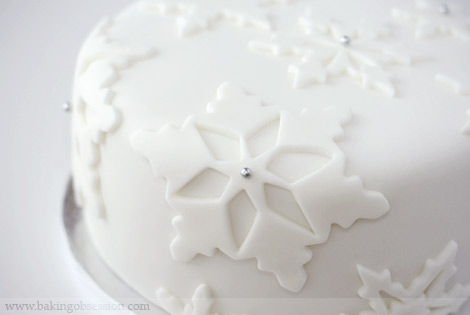
I promised to post the fondant recipe I used for my cake-decorating projects quite a while ago. Well, I guess it’s better late than never.
If you’ve ever sampled a store-bought, ready-to-roll fondant (I’m speaking about the most readily available “wonderful” Wilton product, in particular) you will understand why I decided to master a home-made version. Among other “cons” were the awful smell (intense shortening-like), and the long list of the preservatives and artificial ingredients on the package. It still would be probably acceptable if the molded decorations were considered as décor only. But, on contrary, kids prefer to start from the fondant-made stuff; they always eat the fondant first.
If you’ve never worked with the fondant before, then disregard my criticism above and buy a small package. Do not use it on your cake, but get a feeling of the right density and texture. The fondant should be “soft but firm”, if it makes any sense. I learned from my own mistakes, and don’t want you to repeat mine. First recipe I used called for the exact amount of icing sugar to be incorporated. So, I trustfully kneaded it all into my fondant. That fondant ended up in the garbage bin. It was too dry and stiff to work with. The icing sugar quantity should vary; it depends on the weather conditions. Sometimes, I have a couple of ounces of icing sugar left over; other days I use it all.

The recipe below is adapted from Toba Garrett.
Makes a little bit over 2 pounds, enough to decorate a 9 to 10-inch cake
Ingredients:
- Up to 2 lbs confectioners’ sugar
- 1 tbsp (1 envelope) unflavored gelatin
- ¼ cup cold water
- ½ cup light corn syrup
- 1 tbsp glycerin
- 1 tbsp vanilla extract (if you need a snow-white color, use a clear vanilla extract (unfortunately, it’s artificial))
- ½ tsp white vegetable shortening
Preparation:
Sift 1 ½ pounds of the confectioners’ sugar into a large bowl. Make a well in the center and set aside. Transfer the rest of the confectioners’ sugar into the sieve and set aside as well.
Sprinkle the gelatin over cold water in a liquid measuring cup or in a medium bowl. Let it stand for two minutes to soften. Place the bowl into a saucepan with barely simmering water until the gelatin dissolves, or microwave for 15 seconds on High (the time depends on the power of the microwave; the gelatin should be melted but not boiled ). Do not overheat.
Stir in the corn syrup, glycerin, and the vanilla extract. Return to the microwave and reheat for another 15 seconds on High. Stir again. The mixture should be smooth and clear.
Pour the glycerin mixture into the well in the icing sugar and stir with a wooden spoon until combined. The mixture will be very sticky.
Sift some of the remaining icing sugar over a non-stick silicone mat and transfer the sticky fondant from the bowl onto the mat. Sift a little bit more icing sugar over the fondant and start to knead. Wear disposable gloves if you have them. Or, better yet, plan ahead and buy the gloves before you start. Gradually add more icing sugar as you knead; use a plastic/silicone pastry scraper to lift the fondant that sticks to the mat. You aim to get a smooth, pliable mass; firm but soft. Rub the vegetable shortening into your palms and knead it into the fondant. This relieves the stickiness of the fondant.
Wrap the fondant tightly in plastic wrap twice, then place in a plastic bag. Allow the fondant to rest for 24 hours before using. I can’t confirm a long storage life since I always use it within 2 or 3 days; I store it at room temperature.

April 12, 2016 at 6:56 pm
Just wondering if you’ve tried making ahead and freezing. My son turns 2 at the end of the month and it would help if I could do some of the prep up front.